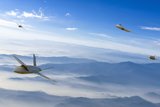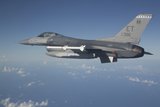Collins Aerospace completes MS-110 reconnaissance system flight testing and prepares for deliveries
The MS-110 sensor leverages Collins Aerospace's multispectral imaging experience from the SYERS-2C flown on the Lockheed Martin U-2. (Photo: Collins Aerospace)
After completing flight and ground testing, Collins Aerospace has begun delivering MS-110 multispectral airborne reconnaissance systems to undisclosed international customers.
The first flight of the system took place in July 2022.
The MS-110 is an improved version of the DB-110, and existing operators of the old systems can upgrade their pods to the MS-110 configuration at their own maintenance facilities, limiting cost and operational downtime.
Related Articles
Farnborough 2016: Ton target for MS-110
Collins Aerospace completes first flight of MS-110 airborne reconnaissance pod
The company is in the process of delivering a total of 16 sensors to international fast jet operators and is in various stages of contractual activities for another 13 pods for three additional customers.
The MS-110 builds on the widely deployed DB-110, with which it shares a common support and imagery exploitation infrastructure.
The multispectral features of the MS-110 are designed to improve intelligence analysts' ability to extract vital information from a wide variety of target sets.
The MS-110 sensor provides day and night, wide-area and long-range reconnaissance with three enhancements from the DB-110: the ability to image in multiple spectral bands, improved optics for increased image resolution and area coverage, and common ground coverage between all bands.
Collins Aerospace airborne reconnaissance systems have been fielded and operational on tactical fast jet platforms such as the Boeing F-15 and Lockheed Martin F-16 fighter aircraft, as well as special mission ISR business jets.
The system is compatible with MALE UAVs such as the General Atomics MQ-9.
The MS-110 sensor leverages Collins Aerospace's proven multispectral imaging (MSI) expertise from SYERS-2C flown on the Lockheed Martin U-2.
It can be integrated with UTC's TacSAR (Tactical Synthetic Aperture Radar), an advanced sensor pod that provides commanders with vital all-weather ISR by integrating the Selex-ES AESA.
Related Equipment in Defence Insight
More from Digital Battlespace
-
![Babcock nears first customer for Nomad AI translation tool]()
Babcock nears first customer for Nomad AI translation tool
Nomad can provide militaries with real-time intelligence, saving critical time on the battlefield.
-
![AUSA 2025: Israel’s Asio Technologies to supply hundreds of improved Taurus tactical systems]()
AUSA 2025: Israel’s Asio Technologies to supply hundreds of improved Taurus tactical systems
Taurus operates alongside the Israel Defense Forces’ Orion system which supports mission management across tens of thousands of manoeuvring forces, from squad leaders to battalion commanders.
-
![AUSA 2025: Kopin pushes micro-LED plans as China moves faster]()
AUSA 2025: Kopin pushes micro-LED plans as China moves faster
The plan for the new displays follows fresh investment in Kopin’s European facilities by Theon and an order for head-up displays in fielded aircraft, with funding from the US Department of Defense.
-
![AUSA 2025: Persistent Systems to complete its largest order by year’s end]()
AUSA 2025: Persistent Systems to complete its largest order by year’s end
Persistent Systems received its largest ever single order for its MPU5 devices and other systems earlier this month and has already delivered the 50 units to the US Army’s 4th Infantry Division.
-
![Aselsan brings in dozens of companies and systems under the Steel Dome umbrella]()
Aselsan brings in dozens of companies and systems under the Steel Dome umbrella
Turkey has joined the family of countries attempting to establish a multilayered air defence system with government approval in August 2024 for the effort landed by Aselsan. Dubbed Steel Dome, the programme joins Israel’s Iron Dome, the US Golden Dome, India’s Mission Sudarshan Chakra and South Korea’s low-altitude missile defence system.
-
![DSEI 2025: MARSS unveils new agnostic multidomain C4 system]()
DSEI 2025: MARSS unveils new agnostic multidomain C4 system
MARSS’ NiDAR system has been deployed using sensors from static platforms to provide detection and protection for static sights, such as critical infrastructure, ports and military bases.




























